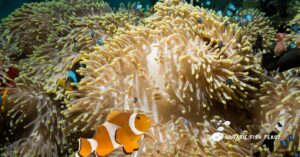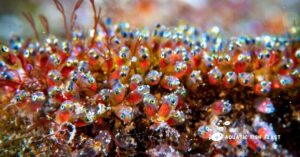Do you want to know how many clownfish species are there? Yes, I want to know how many clownfish species are there.
Amphiprion percula and Amphiprion ocellaris, two of the almost 30 species of clownfish, are generally known as the orange clownfish. Clownfish of the genus Percula have a bright orange color along with white stripes bordered by black.
All newborn clownfish are male. Eventually, the dominant male will become a female, and the two clownfish will form a pair.
Both parents care for the eggs laid by the female until they hatch. But that is not all; however, as you read further, I will explore how many clownfish species are there and a lot more.
Now, let’s get started.
Table of Contents
How Many Clownfish Species Are There
There have been a total of 30 different species of clownfish have been identified so far. The majority of them come from the regions of the Red Sea, western Pacific Ocean, and Indian Ocean that have higher water temperatures.
The Mediterranean, the Caribbean, and the Atlantic oceans are not part of their native environment in any way.
“Orange Clownfish” is most commonly used to refer to two of the 30 known species: Amphiprion ocellaris and Amphiprion percula. The second is distinguished from the first by having a brilliant orange body and white bars with a black border around them.
What Are The Most Popular Types Of Clownfish Species
Because they are so traditional and simple to breed, these fish have also served as the foundation for numerous designer species, as we will discover.
Let’s take a closer look at these fish down below:
1. the snowflake
The snowflake clownfish is a moderately common species. These fish, which range in grade, are the product of selective breeding of ocellaris clowns.
When completely developed, snowflake clownfish may reach around 4 inches. The key distinguishing factor between snowflakes and ocellaris clowns is the variation in the width of the white stripes, which is observed across different individuals.
There are three distinct classifications of snowflake clownfish, namely snowflake ocellaris, premium snowflake ocellaris, and super snowflake ocellaris, which are determined by the extent of variation within this particular breed.
2. Pablo Picasso
The Picasso clownfish is another popular variety at your local aquarium store. Based on the percula clownfish (Amphiprion percula), these fish are 3 inches long.
Like snowflake clownfish, Picasso clownfish possess elongated white stripes with a gradient pattern. The orange pigmentation of percula clownfish may have occasional yellow tints. Picasso clownfish are classified into two types: standard and premium.
The Clownfish Picasso. The Picasso clownfish exhibits prominent, elongated white stripes that are particularly conspicuous inside the central and third bands.
3. Frostbite
The maximum length attained by Frostbite clownfish is around 4 inches. The bodies of these organisms exhibit a mostly white coloration, except for specific areas that resemble the visual manifestations associated with frostbite, hence earning them the designation of “designer.
” Interestingly, these fish darken with age; even if you have a young frostbite clownfish with many orange spots, those spots will eventually darken until they are black.
4. Wyoming White
These fish resemble Maine blizzard clownfish in appearance. On the other hand, Wyoming white clownfish were produced from ocellaris clowns, while Maine blizzard clownfish were created from percula clowns.
The distinction is subtle, but it may be observed in the color of their eyes and the number of spines on their dorsal fin.
Otherwise, Wyoming white clownfish may reach a length of 4 inches. The black mark directly above the gills stands out against the virtually all-white body of these fish. As the fish develops, all orange markings will fade to black.
Where Does A Clownfish Species Live In The Wild
A few clownfish are frequently kept in aquariums, but the ocellaris clownfish is the most popular. Let’s examine some locations in the wild where you could find some of the most prevalent Clownfish species.
1. The Ocellaris clownfish, also known as the fake percula clownfish or common Clownfish (Amphiprion ocellaris), may be found in the western Pacific and the eastern Indian Ocean.
Essentially, both the eastern and western halves of Australia! It is possible to locate it in the shallows.
2. The True Percula Clownfish, also known as the Picasso Clownfish or Amphiprion percula, may be found in the shallow seas along the northwestern coast of Australia, as well as in Japan and Southeast Asia.
3. The Tomato Clownfish, also known as Amphiprion frenatus, may be found in the Western Pacific, Southeast Asia, and Japan. Shallow reefs every time.
4. The maroon clownfish, also known as Premnas biaculeatus, may be found in the Western Pacific, Southeast Asia, northern Australia, and up to Japan.
5. The Clarkii clownfish has a wide range, ranging from the Persian Gulf in the west to east Australia and further afield in the archipelagos.
As a consequence of this, the species of host anemone that it is most partial to is not very well-defined.
The depth at which the Pink Skunk Clownfish lives is more significant than most other species. It is possible to find it off the western and eastern coasts of Australia and all the way up to southern Japan in the north.
What Is The Best Type Of Clownfish Species
This topic is asked rather frequently, but the honest answer is that there is no one correct response.
Because every hobbyist has their tastes, skill level, and aquarium size, it is entirely up to the fishkeeper to decide which of the options on this list is best for them to maintain based on the information provided in this article.
The Percula Clownfish is undoubtedly the most well-liked kind of clownfish because they are more frequent than the other sorts, less challenging to care for, and more docile in temperament.
What Are The Rarest Clownfish Species
The solution, in a word, is McCullochi (more specifically, Amphiprion mccullochi).
An Explanation Of:
The island of Lord Howe, located off the coast of Australia, is the natural habitat of the McCulloch Clownfish.
Because fishing is prohibited in its small native habitat, this species of clownfish is one of the most difficult to find in the aquarium industry.
It has a white tail and a single white stripe on its head, and its standard color ranges from dark brown to black.
Juveniles are darker in color most of the time and have three distinct bands on their backs. They are around the same size as the other fish living in the Tomato Complex, but they tend to be more hostile.
How Many Colors Of Clownfish Species Are There
Depending on the species, the clownfish comes in various hues, including yellow, orange, red, and black. The majority have white details. They are tiny fish, the smallest being around 7 to 8cm long and the largest about 17cm long.
In addition, here are five bright and daring Clownfish:
1. The orange Clownfish (Amphiprion percula).
The orange clownfish or clown anemonefish is the most well-known and recognizable bold and colorful clownfish. You might recognize these adorable tiny sea creatures as Nemo and Marlin from Finding Nemo.
The orange clownfish is a brilliant orange with three distinct white stripes. Thin black lines divide the white and orange colors as well. The orange clownfish, like other clownfish, is symbiotic with sea anemones.
The anemone provides the clownfish with a habitat and scraps to eat, and the fish protects the anemone.
2. Amphiprion polymers (Saddleback Clownfish)
The fact that it only has a partial center stripe on the middle of its body distinguishes this fish. This marking resembles a saddle for a horse, which is why this adorable fish is known as the saddleback clownfish! In addition, there is a black saddleback clownfish with a complete center band.
Saddleback Clownfish can range from dark brown to bright orange, with two or three prominent white bars. These colorful and bright clownfish may be found around the Indo-Pacific area, including Northern Australia.
3. Amphiprion perideraion (Pink Skunk Clownfish)
You can tell where this next clownfish gets its name by looking at it. The pink skunk clownfish gets its name from the prominent white stripe that runs from its snout to its tail, precisely like a skunk! The body of the fish is a peachy or pink color.
It also has a white stripe running from the top of its head to below its eye. Pink skunk clownfish are tiny clownfish, only measuring around 3.9 inches long.
The clownfish, characterized by its vibrant colors, may inhabit the temperate waters of the tropical Western Pacific and Indian Oceans.
4. Amphiprion latezonatus (Wide-Band Anemonefish)
The wide-band anemonefish, which lives off the east coast of Australia, has a dark brown body with three huge white stripes and a white section on the tail fin. The fish’s name comes from the extra-wide center stripe on its body.
Some fish have electric blue coloring on their top lips and an outline of these enormous white bars. Wide-band anemonefish can exhibit yellow or orange dorsal fins. These daring and elegant clownfish are choosy about where they dwell and are usually found near sebae anemones (Heteractis crispa).
Final Thoughts
Now that we have established how many clownfish species are there, as you can see, the clownfish can do much more than just being orange, black, and white.
They come in a variety of colors, temperaments, and sizes. If you don’t want to commit for that long, you may select between a fish that lives a few years and one that lives over 20 years.
If kept under the proper circumstances, these clownfish may be a delightful addition to your aquarium. Choose wisely based on compatibility, and relish the look of your new tank companion.
OTHER ARTICLES:
- Can Clownfish Eat Bloodworms(Have You Seen This)
- Can Clownfish Live In Freshwater
- Are Clownfish Aggressive: Discover Now!
- Can Clownfish And Goldfish Live Together
- Can Clownfish And Dory Live Together
- Can Clownfish And Seahorses Live Together
- How Many Clownfish Should Be Kept Together
- How Many Clownfish Can Safely Coexist In A Tank




